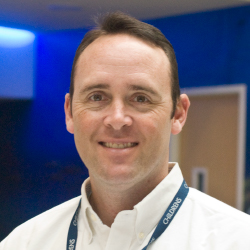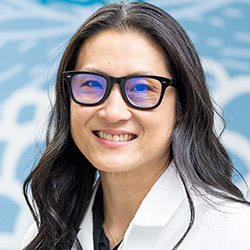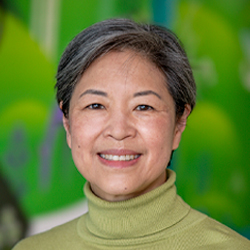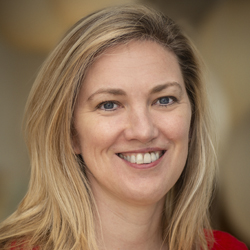Facial Reanimation
Contact Us
To make an appointment, you or your child’s doctor can call the Craniofacial Center at 206-987-2208.
We encourage you to talk with your primary care provider about coming to see Seattle Children’s specialists. This helps coordinate your care.
What is facial reanimation?
Facial reanimation procedures help children move their face or make more even movements on both sides of their face.
The nerve that controls the face muscles is called the “facial nerve.” One facial nerve comes out of each side of the skull near the ear. These two main nerves divide into many smaller branches that connect to different face muscles.
If the facial nerve does not work properly, it will affect your child’s ability to move the muscles in their face. Those muscles will be paralyzed. This is sometimes called “facial palsy.” Facial palsy usually affects 1 side of the face. Some children have a condition that affects both sides of their face.
Children who have facial reanimation procedures may benefit in these ways:
- Facial expression that matches more closely from side to side
- Better ability to eat
- Better ability to speak clearly
- Better ability to express their feelings through their face and to interact with others
- Fewer problems with dry eyes or extra tears because their eyelids can close tightly
Who can benefit from facial reanimation?
Any child who cannot move part or all of their face because of a problem with the facial nerve might benefit from facial reanimation. We treat children with many types of conditions, including:
- Craniofacial microsomia, also called hemifacial microsomia
- Moebius syndrome, also called congenital facial diplegia
- Traumatic injury to the facial nerve, such as during birth or from an injury
- Bell’s palsy, in which the facial nerve stops working all of a sudden
- Problems because a tumor near the facial nerve was removed
- Other facial nerve problems that children may be born with (congenital) or that may happen later
Why choose Seattle Children’s for facial reanimation?
Seattle Children’s Facial Reanimation Program is the only one of its kind for children in the Northwest. We do many types of facial reanimation. Our experienced team and advanced technology help your child get better faster.
-
Minimally invasive procedures
We use minimally invasive procedures to reduce scarring and help your child get better faster.
During surgery, we make a small incision to access the facial nerve.
On the leg, we make a small incision along the inner thigh to remove a short piece of the muscle (gracilis muscle). The incision is small enough to be hidden by shorts or a skirt.
-
Team approach
Each child who comes to Seattle Children’s with a facial nerve problem is assessed by a team of providers from many areas of healthcare. This multidisciplinary approach helps us learn about your child’s condition and give the best treatment just for them. The team may include pediatricians, surgeons, feeding specialists, speech therapists, radiologists, nurses, social workers and many others.
The exact team for your child depends on your child’s needs. For example, if there’s a problem where the facial nerve comes out of the skull near the ear, your child’s team may include an ear-nose-throat specialist (otolaryngologist). If there’s a problem with the facial nerve inside the skull, your child may need a neurosurgeon.
-
3-D imaging for precise planning
High-definition video and 3-D imaging of your child’s face and head help us plan their treatment.
Surgeons use the images as a guide when doing complex procedures. We use the technology to measure treatment results and constantly make our techniques better.
-
Coordinated care
We work with you to make a care plan that works for your child and your family. Our team members work together to coordinate care before, during and after surgery. We are there to help your child adapt to changes in their face after surgery.
Facial Reanimation Procedures
-
Eyebrows
If 1 eyebrow does not move and the other does, doctors can inject Botox into the moving eyebrow to paralyze it. This way, your child’s eyebrows match on both sides.
This treatment usually lasts less than 6 months. Your child would need repeat injections.
-
Eyelids
If your child’s eyelids do not close, surgeons may place tiny gold weights inside the upper lid to help pull it down. They may use a small piece of tendon to create a sling that pulls the lower eyelid up.
-
Mid-face
If the area around the mouth does not move, surgeons may take a muscle from your child’s inner leg (gracilis muscle) and move it to your child’s face. They connect 1 end of this muscle to the cheekbone and the other end to the corner of the mouth. They connect the muscle to working nerves, like the ones that help you chew. This procedure is sometimes called “smile surgery.”
-
Lower lip
If 1 side of the lower lip does not move and the other does, doctors use 2 different ways to make the lip match from side to side. They may inject Botox into the moving side to paralyze it. Or, they may recommend taking the muscle out on the moving side.
-
Timing for procedures
Facial reanimation is usually done when your child is 4 or 5, but the procedures can be done at any time. Doctors want to do a procedure early enough to get the best results possible but also wait until your child’s body grows big enough to safely do these procedures. The ideal age is around 4.
Advantages to having the surgery early include:
- Eye protection: Facial reanimation can help the eyelids close more tightly. This protects the eye better and lowers the need for lubricants and eye drops. It lowers the risk of injury to the clear covering on the front of the eye (cornea). If the cornea becomes swollen (keratitis), it can lead to blindness.
- Speech and language development: Smile surgery at a younger age may improve a child’s speech and language development and social interactions.
Who is on the facial reanimation team?
Our board-certified surgeons and our speech and language pathologist (SLP) work together to plan and carry out treatments for your child.




